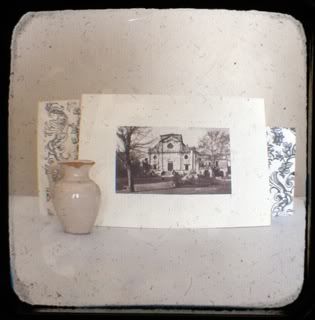
A little while ago, I became fascinated with TtV photography. TtV stands for Through the Viewfinder, and it’s one way to bring obsolete cameras back to life and spice up über-modern digital photography with a bit of an analog look.
TtV involves using two cameras to take a photo. One camera must be functional: a DSLR, a point-and-shoot digital camera, a modern film camera, or even a cell phone camera will work.
The other camera will be used strictly for its viewfinder. So the larger and more interesting the viewfinder, the better. The Argus Argoflex is perfect for this, as its viewfinder has approximately a 2” diameter. But as you’ll see a bit further down, many other cameras, including ones with small viewfinders, can also be used for different effects.
The process is quite simple. Step one: frame your shot using the older camera.
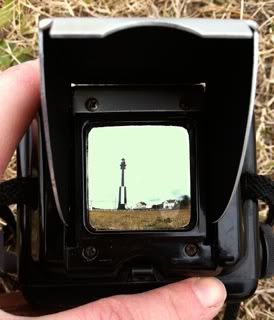
New Cape Henry Light is framed in the viewfinder.
Step two: use the other camera to take a photo of the viewfinder… just like I’ve done above. Step 3: Crop the photo to your liking. One benefit of TtV photography is that the edges of the viewfinder create an automatic frame for your image… like so:
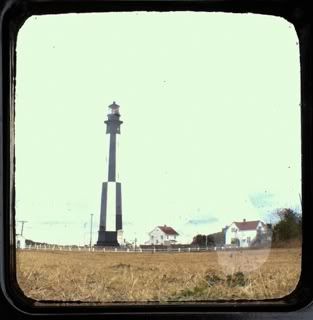
And that’s it!
In addition to a somewhat irregular frame, the image may also be somewhat distorted (note the slightly curved horizon line above) or have dust specs. But these imperfections are all part of the fun.
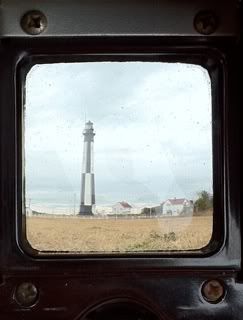
Ft. Story again. Here, the sky is less blown out, and I’ve left some more of the camera body in the image for a chunkier frame.
TtV is also great for still life photography at home:
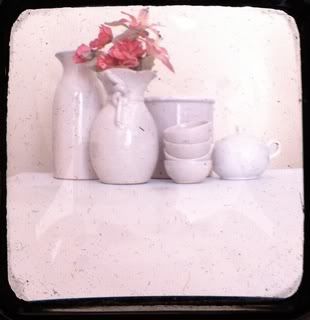
Here, I arranged some of my beloved ceramics from Vietri and some silk flowers. I was curious what this would look like with the camera set flat on the table. But if I were to do it again, I would probably prop it up at an angle, to shoot up higher.
TtV is one way to add some imperfections and analog charm to your photos, to give them a different character. Many old cameras will have plenty of dust in the viewfinder to add plenty of rustic charm to your images. But be careful not to focus on the dust specs, or your subject will be blurry while the dust specs take over:
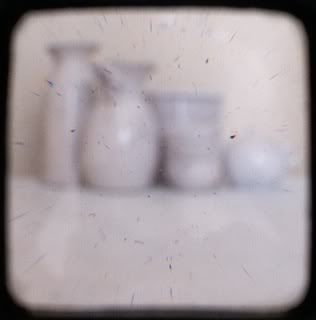
I didn’t realize it was THAT dirty inside!

Ah, much better.
All of the above images were taken with the Argus Argoflex. But other cameras with much smaller viewfinders work as well. Here is a sample of images taken through teeny tiny viewfinders, all about the size of my pinky fingernail:
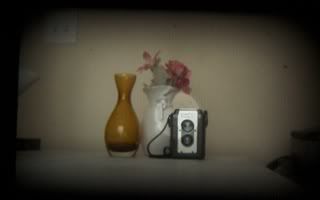
The Argoflex and a couple of vases through the viewfinder of an Argus 75, a 35mm camera from the 1970’s.
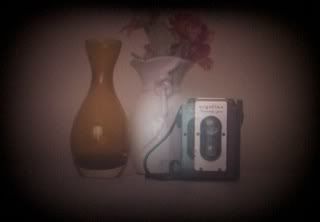
Canon AE-1. The light spot in the middle is the manual focus assist.
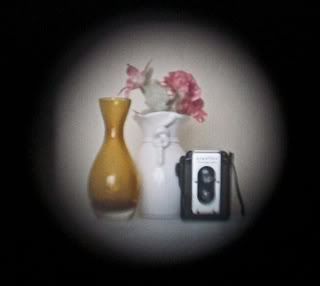
Even the Holga’s small round viewfinder will work!

And… the Contaflex! Here, the focus assist and the surrounding ridges are clearly visible.
As you can see, the shape, color tint, and any other characteristics of the viewfinder all affect the final image. And yes, TtV can be done even with film. Check out these images, taken with a Canon AE-1.

Looking down into the Argus Argoflex. I used black and white 35mm film, then scanned it as a color negative film to give it the slightest hint of cream-tone color.

I have a few more TtV projects in progress, so look for more on this topic in the next few months.
And a very Happy New Year to you all! May 2011 bring us all health, peace, good times with family and friends, and last but not least, plenty of opportunities to take photos. ☺
 I've been having fun with collages lately. My newest one shows six segments of a beach scene at Fort Story, one of my favorite places to enjoy the Virginia scenery and experiment with cameras. These photos were taken with a Canon EOS Rebel, with a plastic Diana lens attached via an adapter. I loaded the camera with black and white 35mm film, which I then scanned using the color setting, giving the images the slightest hint of color.
I've been having fun with collages lately. My newest one shows six segments of a beach scene at Fort Story, one of my favorite places to enjoy the Virginia scenery and experiment with cameras. These photos were taken with a Canon EOS Rebel, with a plastic Diana lens attached via an adapter. I loaded the camera with black and white 35mm film, which I then scanned using the color setting, giving the images the slightest hint of color.
















